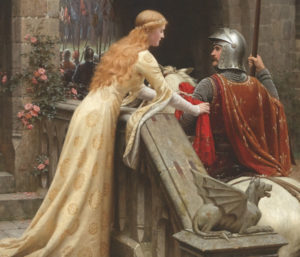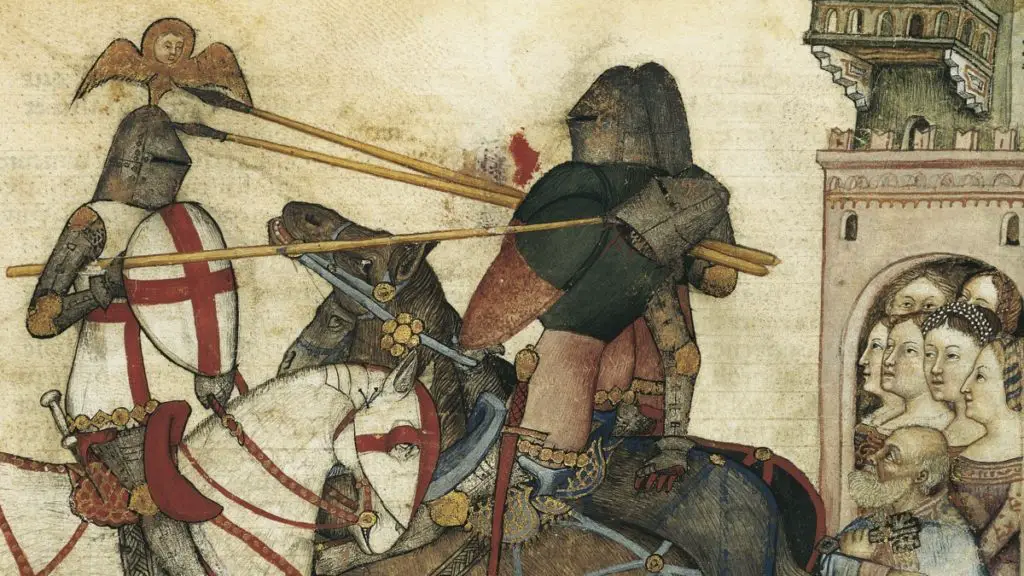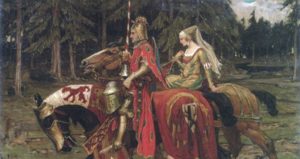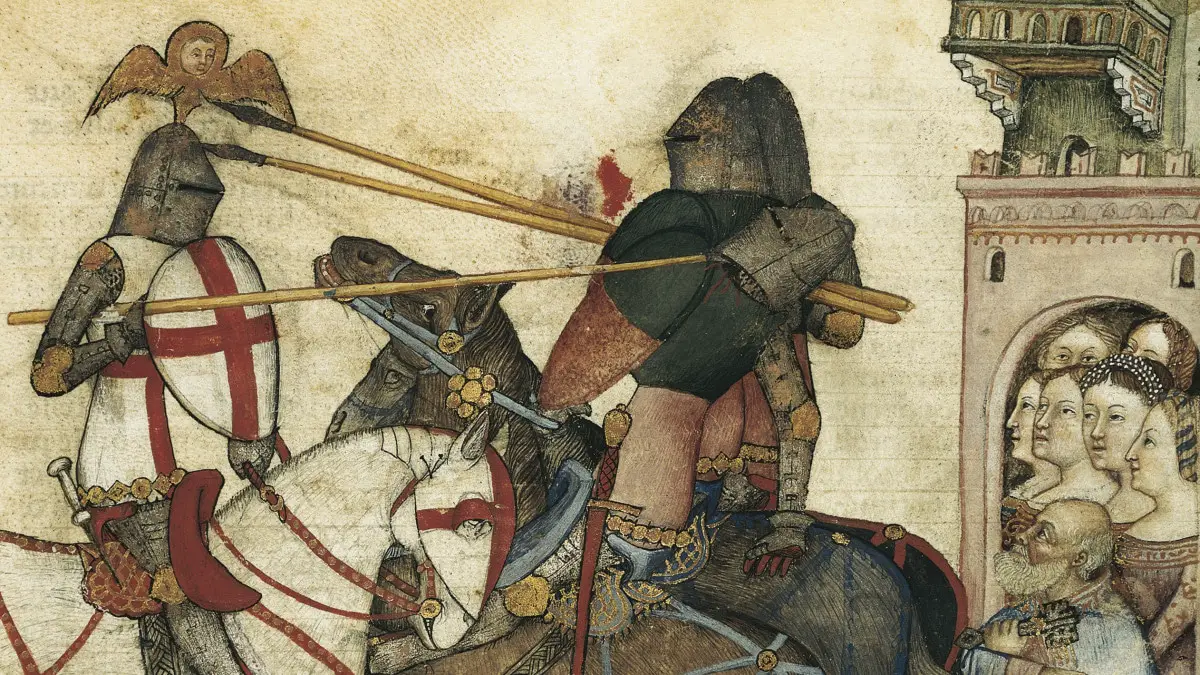The Code of Chivalry in the Arthurian legends is not something that explicitly appears in the earliest records of Arthur, but it is a key aspect of the medieval romances. It was essentially the moral code of conduct by which Arthur and his men had resolved to live by. These standards made Arthur’s reign the peaceful and glorious thing that it was famous for being, and the downfall of his kingdom is associated with the discarding of this Code of Chivalry.
In real life, codes of chivalry had been developed and propounded by different individuals and groups during the medieval period. It was expected that knights would temper their brutal and violent lifestyle with virtuous qualities and modes of conduct.
The display of chivalry featured in the Arthurian legends had a profound impact on western society during the height of the popularity of those legends in Europe. King Arthur’s reign was viewed as the idealised example of courtly virtue. Let us first look into the development of this courtly Code of Chivalry throughout the early development of Arthurian lore, and then we shall consider what the code actually was, as well as what historical basis it may have had.
Development of the Code in Arthurian Lore
 The first hint of Arthur as a symbol of exceptional virtue appears in one version of the Historia Brittonum. In this manuscript version, Arthur is termed ‘magnanimous’. This is not a comprehensive description of all types of moral virtues, but it does reveal that Arthur was believed to have at least been magnanimous. Admittedly, though, we cannot be completely certain that this description dates back to the original writing of the Historia Brittonum, since it is not in all versions.
The first hint of Arthur as a symbol of exceptional virtue appears in one version of the Historia Brittonum. In this manuscript version, Arthur is termed ‘magnanimous’. This is not a comprehensive description of all types of moral virtues, but it does reveal that Arthur was believed to have at least been magnanimous. Admittedly, though, we cannot be completely certain that this description dates back to the original writing of the Historia Brittonum, since it is not in all versions.
In Geoffrey of Monmouth’s Historia Regum Britanniae (HRB), written in c. 1137, the description of Arthur matches this aforementioned description very well. When he is first introduced in Book 9, as a 15-year-old who has just been crowned, he is described as having ‘unparalleled courage and generosity’. The descriptions of Arthur later in that same work continue to convey the same idea about the king.
So apparently, according to these relatively early Arthurian sources, Arthur was exceptionally virtuous in at least some ways.
And what about his court? If the king was virtuous, we would expect his court to be so as well. According to the HRB, this was precisely the case. It claims that Arthur introduced ‘such a code of courtliness’, according to one translation, or ‘such politeness into his court’, according to another, that other nations found it worthy of their imitation.
The account does not go into great detail about what exactly this ‘code of courtliness’ involved, but in the same context it does highlight the fame of Arthur’s ‘munificence’, essentially the same quality as the generosity mentioned earlier in the HRB and the magnanimity mentioned in the Historia Brittonum.
This passage also makes mention of Arthur’s valour, and this same quality is mentioned as the quality that Arthur looked for when inviting others to his court. Just as Arthur’s munificence here parallels his generosity in the description of his youth, this quality of valour here parallels the quality of courage mentioned regarding his youth.
The account goes on to highlight the valour of Arthur’s men as being the quality which was particularly esteemed by the women of the era, saying that women would only consider as worthy of their love those who had proved their valour in at least three battles.
So we can see that at this point in the development of the Arthurian lore, two qualities that are especially highlighted as evidently being included in Arthur’s code of courtliness are generosity and courage.
Of course, this is not an extensive list of qualities. But it does reveal that even at this relatively early stage of the Arthurian legends, King Arthur was said to have promoted at least one quality related to day-to-day virtue – that is, generosity. And the second quality he was notable for promoting was related to one’s behaviour in battle – that is, courageousness.
So the two fundamental areas of the later Code of Chivalry were already there by c. 1137 at the latest. Now, let us examine what the actual Code of Chivalry in the medieval romances really was.
The Code of Chivalry
There is no single list of all the characteristics of chivalry in the Arthurian romances. Nevertheless, the understanding of society at the time the tales were written gives us an insight into what the writers had in mind when they spoke of chivalry. Furthermore, the behaviour demonstrated in the tales themselves reveals what kind of behaviour was considered to be involved in this Code of Chivalry.
From the 12th century to the 14th century, one particularly famous and popular source of chivalrous behaviour was the Song of Roland, a poem composed around the turn of the 12th century. It concerns the time of Charlemagne, and the titular character, Roland, is one of Charlemagne’s knights.
In this story, Roland is portrayed as dying while courageously and selflessly fighting the enemy with his army alone, instead of blowing a horn to call Charlemagne for backup, which would have risked the lives of his king and his king’s men. Roland’s behaviour in this story was considered to set the basic standard for chivalry, and a Code of Chivalry is outlined in the poem:
- To worship God and uphold his Church
- To serve one’s lord with valour and faith
- To protect those who are weak and defenceless
- To assist widows and orphans
- To avoid deliberately giving offence
- To live honourably and for glory
- To despise monetary reward
- To fight for the benefit of all
- To obey those in positions of authority
- To guard the honour of fellow knights
- To refrain from unfairness, cruelty and deceit
- To keep faith
- To always speak truthfully
- To persevere to the end in any enterprise begun
- To respect the honour of women
- To never refuse a challenge from an equal
- To never turn one’s back upon an enemy
These standards of conduct were very likely the virtues held in the minds of the writers of the Arthurian romances when they referred to ‘chivalry’, given the popularity both of this poem and the concept of chivalry in general during the time period in which the romances were written.
Many of these virtues are seen in action in the Arthurian tales. For example, the importance placed on a knight’s word is heavily portrayed in the romances. This is seen from instances where a knight gives his word that he will perform a certain action, such as meeting his listener at the same place the following year for a duel or to provide them with something, and the knight invariably fulfils his word or is completely expected to fulfil it. One example of this is seen in the tale The Wedding of Sir Gawain and Dame Ragnelle.
The characteristic of being loyal to one’s lord is aptly demonstrated by the loyalty of Arthur’s knights throughout the romance tales.
In like manner, the legends display countless examples of courage and heroism, especially in the endeavour of protecting women. These examples fittingly portray the qualities of ‘never turning one’s back upon a foe’ and ‘respecting the honour of women’. These acts of heroism also display the quality of ‘protecting those who are weak and defenceless’.
A Historical Basis?
 An interesting question that arises is, Does the concept of a Code of Chivalry in Arthur’s court have any historical basis? Even though the writers of the medieval romances describe there being such a code of conduct in Arthur’s court, it could just be the case that they were inserting their own ideas of a king’s court onto the legends. After all, this is exactly what they did when describing the physical buildings or what was involved in certain royal proceedings.
An interesting question that arises is, Does the concept of a Code of Chivalry in Arthur’s court have any historical basis? Even though the writers of the medieval romances describe there being such a code of conduct in Arthur’s court, it could just be the case that they were inserting their own ideas of a king’s court onto the legends. After all, this is exactly what they did when describing the physical buildings or what was involved in certain royal proceedings.
Is there any way of confirming whether or not there was a historical basis to the Arthurian Code of Chivalry? Well, it goes without saying that archaeology cannot be used to test for such a thing. However, what we can do is look at the very earliest written information and see what we can gather from that.
We already saw that one version of the Historia Brittonum described Arthur as ‘magnanimous’. But let us go back even further than the Historia Brittonum.
The very earliest source for the era covered by Arthur’s reign, if it really took place, is Gildas’s De Excidio. This source is unfortunately not an extensive history book, but it does reveal some indications about what the period was like.
After describing the victory at Badon, Gildas claims that those who lived at this time (including kings and noblemen) lived ‘orderly and by their several vocations’. But the generation that lived in the peace established after the Battle of Badon did not appreciate the severity of the Saxon menace.
According to Gildas, this younger generation grew up to cause disorder and bring about an era of civil wars. In doing so, Gildas claims that they rejected the morals, virtues and values that had been held previously by all those aforementioned kings and noblemen, as well as others.
This matches very well with what is claimed by the Arthurian legends. Gildas was writing 44 years after Badon, which means that in the stream of time according to the tales of King Arthur, the downfall of Arthur’s kingdom (along with its code of courtliness) occurred a little more than 20 years prior to Gildas’ writing. This would have given ample time for the consequences of the Battle of Camlann to have fully materialised.
But the correspondence between Gildas’ words and the legends is much more specific than just that. Consider, in the HRB, Gawain is presented as being born at about the same time as the Battle of Badon. In the absence of other information, we can assume that his brother Mordred was born at roughly the same time as him – when the Battle of Badon took place. Therefore, this means that Mordred, the one primarily responsible for bringing about the downfall of Arthur’s kingdom, was of the generation that Gildas spoke about.
This means that the legends match perfectly with the information presented by Gildas. The Battle of Badon took place, during which period kings and noblemen lived orderly and according to certain moral values and virtues. Then the generation that did not experience the foreign wars grew up and, led by Mordred, they rejected these values and caused the Britons to be plunged into a period of civil wars.
Clearly, then, Gildas’ description strongly supports the notion that Arthur’s court did promote certain moral values, which moral values were respected until the rebellion of Mordred.
Of course, we do not know precisely what those moral values were. Whether they were all similar to the virtues espoused by later writers of the 12th to the 15th centuries is impossible to ascertain with 100% confidence. However, there is some information that gives as certain indications.
Roman Standards
It is significant to note that there are reports of soldiers being encouraged to hold themselves to certain standards of conduct even before the post-Roman era. One example of this is the sacramentum militare, which was an annual oath taken by the soldiers in the Roman army. This was essentially a pledge of loyalty to the emperor, to always serve him and do as he commanded.
Compare this with the aspect of the Code of Chivalry in the Song of Roland which had to do with being loyal to one’s lord and serving him faithfully.
It is also known that centurions in particular were well respected for their bravery, showing that bravery (or valour) was highly prized in that society.
The work of Cicero in the early history of the Roman Empire also provides us with an insight into what kinds of virtues were respected among Roman society. His words in De Officiis reveal that Roman virtues included magnanimity, just like one of the virtues supposedly displayed by Arthur.
In addition, Cicero highlighted fulfilling one’s obligations and sticking to one’s word, even when the promise was made to an enemy. Treachery and cowardice were despised.
Given that the Romans ruled Britain for almost 400 years, it would not be unreasonable to expect these standards to have still been current in the post-Roman Arthurian era. In fact, it has been shown in other articles that a strong Roman presence remained on the island even after the Roman legions had gone and the island was outside of the Empire.
We know that at least some areas of Britain tried to maintain a Roman-style infrastructure. Furthermore, Gildas’ words concerning Ambrosius (supposedly Arthur’s paternal uncle) give us reason to believe that Arthur’s family was particularly Romanised. This makes it very reasonable to believe that the standards promoted by Arthur’s kingdom would have been very similar to those promoted by Roman society, namely:
- Bravery (valour)
- Loyalty to one’s overlord
- Faithfulness to one’s word
- Trustworthiness
- Magnanimity
All of these virtues are perfectly in line with the Code of Chivalry of the later medieval era.
Another supporting piece of evidence is found from a law code written during the reign of Clovis, a Frankish king contemporary with Arthur. This law code, called the Pactus Legis Salicae, promoted Christian ideals (along with Roman written law and other things). This proves that the concept of a king in Arthur’s time promoting ideals such as those involved in the Code of Chivalry in the Arthurian romances is by no means unrealistic or implausible.
Arthur’s Time
 In view of the aforementioned information, there is really no reason at all for dismissing the concept of a certain ‘Code of Chivalry’ during Arthur’s time. The evidence from Gildas, from the Roman era, and from Clovis’ Pactus Legis Salicae gives overwhelming support to such a concept.
In view of the aforementioned information, there is really no reason at all for dismissing the concept of a certain ‘Code of Chivalry’ during Arthur’s time. The evidence from Gildas, from the Roman era, and from Clovis’ Pactus Legis Salicae gives overwhelming support to such a concept.
If we delve deeper into Gildas’ words, we find more specific support for certain virtues contained in the medieval Code of Chivalry. Firstly, though, let it be noted that it is very likely that Gildas’ reference to the previous generation holding to certain moral standards is probably not just a reference to the general populace. In all likelihood, he was referring to the standards held specifically by those in positions of authority.
This is indicated by the context. Note that he talks about this topic in the context of ones who brought about a period of civil wars. Those in positions of authority, whether princes, magistrates or military leaders, would be in a position to bring about civil wars. So the moral virtues to which Gildas was referring were standards of moral behaviour that applied to the nobility, if not the general populace too.
In any case, what exactly were these historic moral values to which Gildas referred, which the new generation cast to one side? Well, given that he wrote about these in the context of the new generation dragging the country down into a period of civil war, we would expect that they would be values which, if held to, would not lead the country into civil war.
On the basis of this logic, it is likely that Gildas was referring to such values as loyalty to the king and obedience to those placed in authority, just as the Code of Chivalry from the Song of Roland states. This is also precisely what we would expect from a world that was still clinging on to Roman society, wherein the soldiers swore loyalty to the emperor.
In addition, it is likely that truthfulness and trustworthiness would have been included among the virtues to which Gildas was referring, since the bringing about of civil wars (especially in the way in which Mordred supposedly did) definitely involves a lack of those qualities. As with before, these virtues were also viewed as honourable among Roman society.
And, also as before, these virtues are included in the Song of Roland and demonstrated clearly in the Arthurian romances, thus displaying the fact that the qualities we can reasonably expect to have been promoted by Arthur’s kingdom match excellently with the virtues exalted in later centuries.
It is difficult to get more specific than this based on the little information that Gildas supplies. He does not provide as with an exhaustive list of qualities that he considered virtuous and praise-worthy. But at the least, we can see from Gildas’ words that those in Arthur’s court were likely expected to meet expectations of valour in warfare, and apparently also expectations of moral behaviour such as trustworthiness and obedience to those in authority. This perfectly matches the indications from the Roman era.
Conclusion
In this article, we have seen that the Code of Chivalry in Arthurian lore was a code of behaviour that those in Arthur’s court were expected to live up to. It is never clearly and comprehensively defined in any Arthurian source from medieval times, but contemporary descriptions of chivalry reveal what was presumably understood in the romance tales, and these qualities are also seen through the actions of the characters in the romances.
These virtues are fundamentally about loyalty to God and the king, bravery, trustworthiness, and aiding those in need. Despite a general perception that such a Code of Chivalry was invented in medieval times and does not in any way reflect the reality of sixth century Britain, the evidence does not support such a conclusion.
Rather, evidence from Roman culture, a contemporary law code instituted by Clovis, and the words of Gildas (in other words, evidence from before, during and after Arthur) all point towards the conclusion that a very similar code of conduct was indeed in affect in Britain during Arthur’s reign.
We have no way of knowing exactly all the expectations of standards of Arthur’s court, but it very probably involved loyalty to the king (and possibly to God as well, in view of Clovis’ law code), bravery, trustworthiness, and magnanimity.


